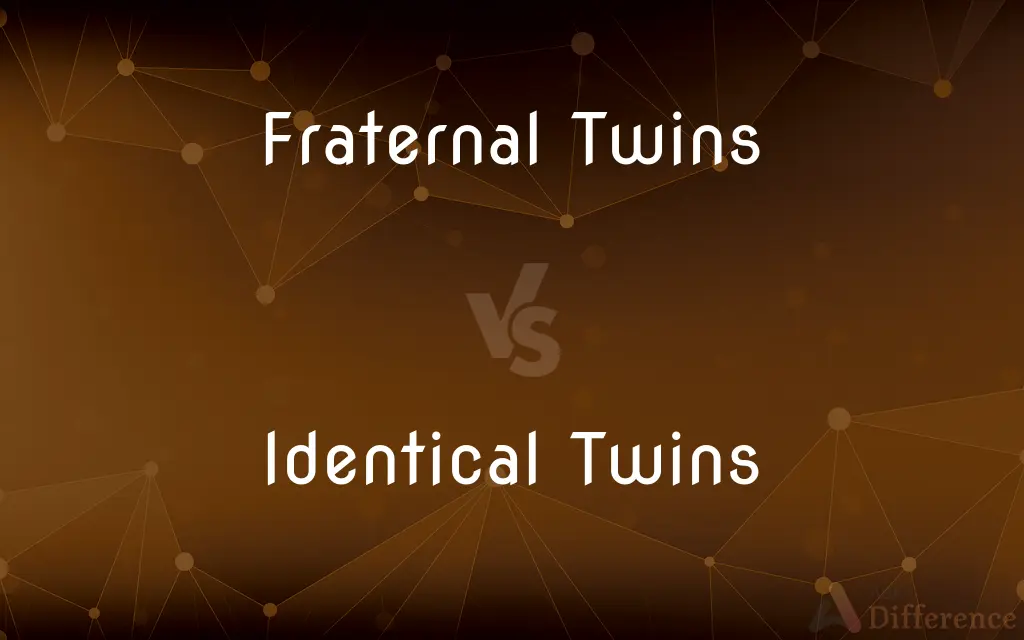Fraternal Twins vs. Identical Twins — What's the Difference?
By Tayyaba Rehman — Published on January 7, 2024
Fraternal Twins are siblings born at the same time but developed from separate eggs fertilized by different sperm. Identical Twins are siblings born at the same time, developed from a single egg that split after fertilization.

Difference Between Fraternal Twins and Identical Twins
Table of Contents
ADVERTISEMENT
Key Differences
Fraternal Twins (dizygotic twins) are the result of two different eggs being fertilized by two different sperm cells, leading to two separate embryos. These twins can be of different genders and have different genetic profiles, much like regular siblings. In contrast, Identical Twins (monozygotic twins) are formed when a single fertilized egg splits into two embryos, resulting in two individuals who have the same genetic makeup.
Fraternal Twins are genetically as similar as any other siblings, sharing about 50% of their genes. They can have different physical characteristics, blood types, and gender. Identical Twins share 100% of their genes, usually resulting in nearly identical physical features and the same gender.
The occurrence of Fraternal Twins can be influenced by factors such as genetics, the mother's age, and fertility treatments. They occur more frequently in certain ethnic groups and families. Identical Twins occur at random and their frequency is consistent across different populations and not influenced by genetics or family history.
In pregnancy, Fraternal Twins usually develop in separate amniotic sacs with individual placentas, although sometimes they can share a placenta. Identical Twins may share an amniotic sac and placenta or have separate ones, depending on how early the fertilized egg splits.
Fraternal Twins may or may not have a close resemblance to each other, just like any siblings born at different times. However, Identical Twins often have strikingly similar physical attributes and can be difficult to tell apart, especially in their early years.
ADVERTISEMENT
Comparison Chart
Genetic Similarity
Share about 50% of their genes
Share 100% of their genes
Development Process
Developed from two separate fertilized eggs
Developed from one fertilized egg that split
Physical Similarities
Can be very different, like regular siblings
Usually very similar or identical
Gender
Can be different or the same
Always the same
Frequency & Causes
Influenced by genetics, age, fertility treatments
Occur at random, not influenced by genetics
Compare with Definitions
Fraternal Twins
Non-Identical Twins
The fraternal twins have different interests and talents.
Identical Twins
Genetic Identicality
The identical twins have the same blood type.
Fraternal Twins
Similar Age Siblings
As fraternal twins, they share their birthday but not their looks.
Identical Twins
Mirror Images
It's challenging to distinguish between the identical twins.
Fraternal Twins
Separate Eggs
The fraternal twins, a boy and a girl, have distinct personalities.
Identical Twins
Exact Physical Features
The identical twins often play pranks by switching places.
Fraternal Twins
Different Genders Possible
The Johnsons have fraternal twins, one son and one daughter.
Identical Twins
Single Egg Split
The identical twins often get mistaken for each other.
Fraternal Twins
Genetic Diversity
Despite being fraternal twins, they look quite different.
Identical Twins
Same Gender
The identical twins, both girls, shared a room growing up.
Common Curiosities
Why do identical twins look exactly alike?
Identical twins look alike because they originate from the same fertilized egg and share the same genetic material.
Do identical twins have the same DNA?
Yes, identical twins have almost identical DNA.
How common are fraternal twins?
Fraternal twins are more common than identical twins, especially with fertility treatments.
What factors increase the chances of fraternal twins?
Factors like maternal age, family history, and fertility treatments can increase the chance of fraternal twins.
Can fraternal twins look identical?
While it's rare, fraternal twins can look very similar, but they do not have identical genetics.
Do identical twins have the same fingerprints?
No, identical twins do not have identical fingerprints, as these develop due to unique environmental factors in the womb.
Are fraternal twins hereditary?
Yes, the likelihood of having fraternal twins can run in families, especially on the maternal side.
Can identical twins have different personalities?
Yes, despite their physical similarities, identical twins can have different personalities.
Do fraternal twins have a special bond?
Fraternal twins, like any siblings, can have a close bond, but it varies individually.
Is it easier to conceive fraternal twins naturally?
The likelihood of conceiving fraternal twins naturally varies based on genetic and environmental factors.
Can identical twins be of different genders?
Identical twins are always of the same gender because they come from the same fertilized egg.
Do identical twins always share a placenta?
Identical twins can share a placenta, but it depends on when the fertilized egg splits. If it splits early, they may have separate placentas.
Are fraternal twins basically like regular siblings?
Yes, fraternal twins are genetically similar to regular siblings, just born at the same time.
How are identical twins formed?
Identical twins are formed when a single fertilized egg splits into two embryos.
Share Your Discovery

Previous Comparison
Array in Java vs. Arraylist in Java
Next Comparison
Civil Servant vs. Public ServantAuthor Spotlight
Written by
Tayyaba RehmanTayyaba Rehman is a distinguished writer, currently serving as a primary contributor to askdifference.com. As a researcher in semantics and etymology, Tayyaba's passion for the complexity of languages and their distinctions has found a perfect home on the platform. Tayyaba delves into the intricacies of language, distinguishing between commonly confused words and phrases, thereby providing clarity for readers worldwide.
















































